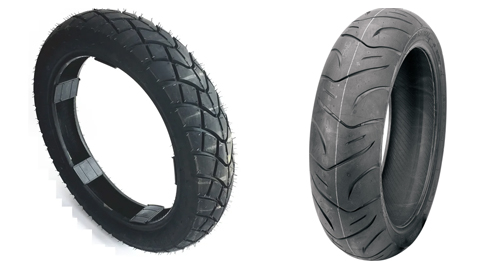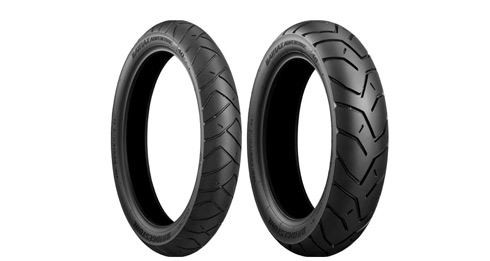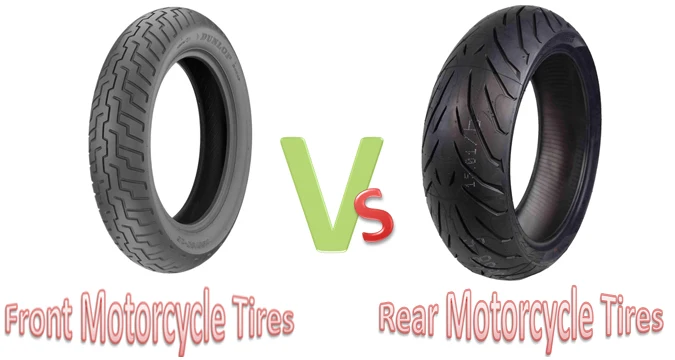Motorcycles are a lot of fun to ride, but just like any vehicle, they require maintenance. The tires are one crucial part that needs regular checking.
Your front and rear tires have different purposes, so it is essential to know the difference between them when you’re inspecting your bike. The rear tire provides power for acceleration, braking, and turning, while the front tire provides steering and handling stability.
This article will look at the difference between front and rear motorcycle tires.
The Purpose of the Front and Rear Motorcycle Tires
The goal of the front tire is to provide light steering and handling stability for your motorcycle. It also allows you to brake, so this tire needs to have a good grip when braking suddenly to stop quickly.
The rear tire gives the motorcycle power by contacting the road during acceleration, braking, and turning. It can also be used as a brake if the ride is experienced enough, but it might just slide out instead of breaking, depending on the type of rear tire you have.
The Main Difference Between Front and Rear Motorcycle Tires

There are a lot of differences between the front and rear tires, but the main ones are:
1. Pitch
The pitch of the front tire helps keep it in contact with the road during braking and cornering, while the rise of the rear tire is primarily vertical.
2. Rotation Direction
The front tire rotates in the same direction as the engine, while the rear tire rotates against the machine.
3. Tire Tread
The front tires have a deeper and more divided tread to keep it gripping with both edges touching the road during braking and cornering; giving more stability and control of the bike. The rear tire is more smooth and only has a center ridge to keep the tire in contact with the road, giving power from traction.
4. Measuring Your Tires
Front tires are measured from one side of the sidewall to the other, while rear tires are measured by their diameter, which is obvious since they’re round.
You can measure both at home without having to go anywhere if you have a ruler and a bike stand.
5. Tire Pressure
The front tire should be filled to about between 28 and 40 pounds per square inch (PSI). The rear tire also shouldn’t be overfilled with air since it can make the motorcycle bounce around when you ride on it, which isn’t safe for you or other motorists around you.
6. Sidewall
The front and rear motorcycle tires also have different sidewalls, but not as much as the tread.
The front tire has a thicker sidewall for durability and to keep it from flexing too much when braking hard or cornering, which can make you lose control of your bike.
The rear tire doesn’t need as much sidewall thickness since it’s not used as much.
7. Speed Rated
Like cars, motorcycles have a speed rating measured in “mph.” For the front tire, you would use the abbreviation “H” for highway and “V” for velocity.
The last letter will be either an “S” (which stands for street) or an “M” (which represents mud). The rear tire is rated by “T” and “W.”
8. DOT Approved
Every tire has a Department of Transportation approval stamp somewhere on its sidewall that tells you what month and the year it was made, as well as where it was manufactured.
It’s not required for tires to be made in the US to carry this stamp, but they do have to pass certain tests.
9. Alternate Tires
Just like cars, motorcycles are allowed to swap around the front and rear motorcycle tires on some models; mostly dirt bikes.
But just because you can do it doesn’t mean you should since it would affect the handling of your bike. Having different size front and rear motorcycle tires is one of the leading causes of motorcycle crashes.
10. Treads Get Worn Out
Regularly checking your tread will allow you to see how much it’s been worn down and therefore estimate when you’ll need new front and rear motorcycle tires.
They usually wear out at about the same rate, but sometimes the front tire wears out more quickly because it’s doing most of the work.
These are the main differences between the front and rear motorcycle tires. Front tires are more important than the rear since they give you better control of your bike, but having good tread on both will help improve the safety of riding your motorcycle.
How to Inspect Your Motorcycle Tires?

Motorcycle tires are one of the essential parts of your motorbike’s safety, but they require regular inspection to see if they need to be replaced. Here are six tips for inspecting your motorcycle tires.
Look at Tread
The tread on your front and rear motorcycle tires should still be visible from different angles when you look at them. Tires are supposed to have print, so if the surface of your tire is smooth, it should be worn out and dangerous to use.
Check for Nails
A nail in your motorcycle tires will go all the way through – which can cause a severe accident because you could lose your grip or control on the first 1-3 inches of your tire where the nail is.
So make sure you check both front and rear motorcycle tires for nails or anything else that might be stuck in them.
Inspect the Edges
The sidewalls of your motorcycle tires are especially susceptible to problems like cuts, blisters, cracks, holes, under-inflation, and much more.
You can’t see too much without taking your motorcycle in for a closer inspection, but you should check the outer edges of your tires to make sure nothing’s wrong.
Look at The Tread Wear Indicators
On the most front and rear motorcycle tires are tread wear indicators that are raised sections on either side of the tire with numbers on them.
The numbers will change as you use your tires, and when they become level with the edge of the tire, it’s time to replace both of them.
Check for Tubes
When you check the tire for cuts, blisters, problems with under-inflation, or punctures – make sure you also take your motorcycle’s tubes out.
Sometimes the tube has a hole in it that doesn’t affect how well your tires can hold air (like if it’s near its end), but other times there will be a problem that needs to be fixed by your motorcycle shop.
When Should You Replace Your Motorcycle’s Tires?
Motorcycle tires don’t last forever, so it’s essential you know when to replace them. Here are five signs that your motorcycle’s front and rear tire need to be replaced:
1. Deformation
The sidewalls of your motorcycle tires shouldn’t bulge out or deform in any way no matter how hard you twist or bend them (with your hands). They shouldn’t have cuts or blisters either.
2. Cutting
Quite simply, you shouldn’t be able to cut the sidewall of your front and rear motorcycle tire with a knife or anything else sharp enough to puncture it.
If there are any cuts in the surface of your tire, it’s damaged and needs replaced.
3. Blisters and Bubbles
Motorcycle tires shouldn’t have any blisters or bubbles in them, and the tread shouldn’t be peeling away either. These are all signs of a tire that’s too worn to use, so you’ll need to replace both your front and rear motorcycle tire as soon as possible.
4. Cracks
If you see any cracks in the surface of your motorcycle tire, it’s too damaged to use. Cracks need to be replaced because they could get worse and lead to even more severe problems with your tires.
5. Weathering
The surfaces of both front and rear motorcycle tires shouldn’t be cracked, torn, blistered, or peeled away. They shouldn’t have any sharp edges or be discolored either.
If your tire looks faded, worn out, or damaged in any way, it’s probably not safe to use, so you should replace both your front and rear motorcycle tire as soon as possible.
Conclusion
Motorcycle tires are an essential part of your bike, and you must inspect them regularly for damage.
The good news is that if you’re vigilant about checking your motorcycle tires and replacing them when they start to show signs of wear, you can keep yourself safe on the road. Remember always to replace both front and rear motorcycle tires simultaneously because they’ll wear down at different rates.

